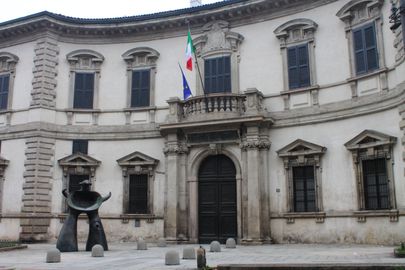

Currently housing the State Archive, the Senate Palace originally housed a religious scholastic institution for the Swiss population in Milan. The commissioner was Milan's Archbishop Cardinal Federico Borromeo, cousin of the great 16th century Catholic reformer and saint Carlo Borromeo. The building was erected in 1608 by architect Francesco Maria Richini over the ruins of an old convent belonging to the Humiliati order.
In 1786 the religious college was suppressed on orders of Holy Roman Emperor Joseph II and the building became the seat of the Austrian government in Milan. When in 1797 Napoleon invaded Northern Italy and set up the nominally independent but in reality pro-French Cisalpine Republic, the edifice became the new government's lower house of parliament. Later, in 1805, when Napoleon transformed the Cisalpine Republic into the officially pro-French Kingdom of Italy, the building was upgraded to the upper house, the Senate. It again became Viennese property when Milan returned to Austria after Napoleon's ultimate defeat in 1815 and was finally made an Italian State Archive only in 1872, after the unification of Italy.
The palace was built in the baroque style with an elliptic façade, whose windows are decorated with triangular tympanums. Inside, it contains two graceful courtyards and according to the opinion of many 19th century Italian aesthetes, the Palazzo del Senato was the most beautiful non-religious structure in Milan.
Like most buildings in the neighborhood the palace was heavily damaged during the Allied bombing of Milan in 1943 and the left wing was entirely rebuilt after the war.
The bronze surrealist sculpture to the right of the entrance, called Mother Ubu, was created by Spanish surrealist artist Joan Mirò in the middle of the 20th century. While the figure on the right, called Personaggio, was made by Italian sculptress Rachele Bianchi.